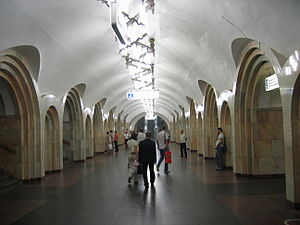- Dobryninskaya
-
Dobryninskaya

Moscow Metro station
Station statistics Coordinates 55°43′44″N 37°37′23″E / 55.729°N 37.623°E Lines  Koltsevaya Line
Koltsevaya LineDepth 35.5 metres (116 ft) Levels 1 Platforms 1 Tracks 2 Parking No Bicycle facilities No Baggage check No Other information Opened January 1, 1950 Code 074 Owned by Moskovsky Metropoliten Formerly Serpukhovskaya Traffic Passengers (2002) 12,702,000 Services Preceding station Moscow Metro Following station PaveletskayaOne-way operationKoltsevaya Line One-way operationPolyankatoward AltufyevoSerpukhovsko-Timiryazevskaya Line Tulskayatoward Bulvar Dmitriya DonskogoDobryninskaya (Russian: Добрынинская) is a station on the Koltsevaya Line of the Moscow Metro. Opened on 1 January 1950 it was part of the first segment of the fourth stage of the system. Originally named Serpukhovskaya (Russian: Серпуховская), after the Serpukhovskaya square.
The station compromises a standard pylon trivault built during the flamboyant architecture of the late 1940s — early 1950s. Architect Leonid Popov (and co-authors M.Zelenin and M.Ilin) based insipired by the historic connotation with respect to the city of Serpukhov, based the overall design on ancient Russian architecture and in particular the Church of the Intercession on the Nerl, which is repeated in the design of the portals and the beige marble composition. Other innovations by Popov include the station walls on the platform halls where above a dark red marble runs white cylindrical marble plintus designed to reflect right into the eyes of passengers. To keep the bright and light appearance of the station, the vaults of the station were left simply plastered and painted white, but the lighting comes froma a zig-zag arrangement of horizontal fluorescent tubes, and the floor in a dark grey granite, typical for Orthodox Churches. Contrasting with the ancient connotation, are 12 bas-reliefs on the pylons by Yelena Yason-Manizer on the theme of the traditional re-creational labour (hunting, fishing, grape-picking etc.) of the different nationalities of the Soviet Union. Yelena Yason-Manizer was also author of the original bas-relief at the end of the station which featured a large profile of Joseph Stalin and Coat of Arms of the Soviet Union. However during the de-Stalinization in 1961 this was removed and in 1967 replaced by the present mosaic by still the same author Morning of the Cosmic Era.
Further works of Popov and co-architect Tatarzhinskaya include the station's large vestibule, located on the corner of Lyusinovskaya Street and Serpukhovskaya square. Once again the portico was based on the ancient Russian connotations and the pillaster was copied from an archeological finding in Taman that dates to Byzantine times. The interior of the vestistibule again diverges into patriotic Soviet themes which include three large floor-to-ceiling mosaics (artists G.Rublev and B.Iordansky) the central one is a large banner with a profile of Vladimir Lenin and the 16 Coats of Arms of Soviet Socialist Republics. The side ones feature images of two Parades on the Red Square, the left one of Soviet athletes and the right of the Soviet Military, which featured a portrait of Stalin being carried, and like the bas-relief in the Central Hall, this was removed in 1961 and then carefully replaced with an image of Yuri Gagarin. Other features of the vestibules include the majestic blue torchieres which flank the escalator ascend and a massive chandelier which is adorned with a large red glass star.
On 6 June 1961 the station was renamed to its present name, in honour of Peter Dobrynin a bust to whom was opened in front of the vestibule. In 1983, the station Serpukhovskaya of the Serpukhovsko-Timiryazevskaya Line was opened (also by work of Popov) and a transfer was created from the middle of Dobryninskaya to the middle of the new station. On 22 December 2006 the vestibule was closed for nearly 18 months during which the old escalators were replaced, new turnstiles were installed and a complete overhall of all communication systems, new security and a thorough restoration was carried out. The renewed vestibule was re-opened on 11 June 2008
Categories:- Moscow Metro stations
- Railway stations opened in 1950
Wikimedia Foundation. 2010.
